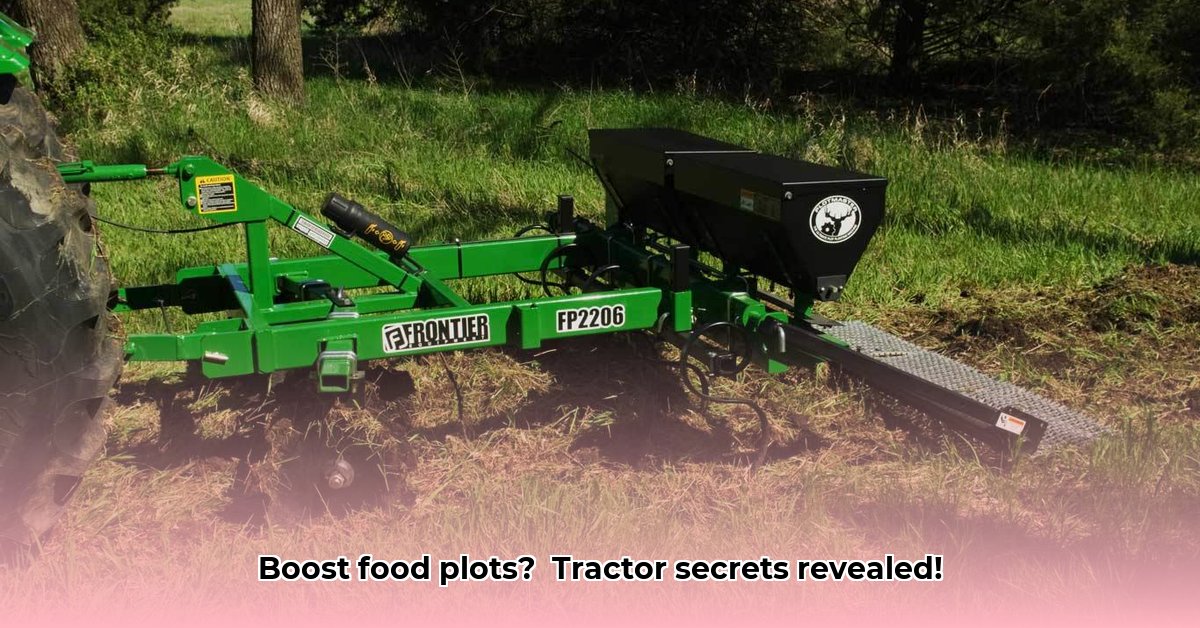
Food Plot Tractor Equipment: Choosing the Right Tools for the Job
Creating a thriving wildlife haven starts with establishing successful food plots. The right tractor and equipment can significantly impact your efficiency and the overall health of your plots. This guide helps you select the ideal equipment for your needs and budget, focusing on sustainable practices. Do you want to maximize your yield while minimizing your environmental footprint? Let's get started. For sprayer tank options, check out tractor supply sprayer tanks.
Assessing Your Needs: Plot Size and Soil Type
Before investing in any equipment, assess your land. How large is your food plot? A small, irregularly shaped area may only require an ATV or UTV with attachments. Larger plots, however, significantly benefit from a full-sized tractor. Likewise, soil type plays a critical role. Heavy clay soils will require more powerful equipment than lighter, sandy soils. What type of soil do you have, and how will this influence your equipment choices?
Tractors: Powerhouses for Larger Food Plots
For larger plots, a tractor offers unmatched power and efficiency. Consider horsepower, the availability of a three-point hitch (for attaching implements), and maneuverability. Compact tractors are ideal for tight spaces, while larger models excel in wide-row planting and heavier-duty tasks.
Pros of Tractors:
- High power output for rapid work completion.
- Exceptional efficiency for expansive areas.
- Wide range of compatible attachments.
Cons of Tractors:
- Significant upfront investment.
- Requires dedicated storage space.
- Potentially overkill for small plots.
ATVs/UTVs: Versatile Options for Smaller Areas
ATVs and UTVs are well-suited for smaller, less accessible plots, especially those with challenging terrain. They are maneuverable, relatively affordable, and offer numerous attachment options. However, they have lower power and capability compared to tractors.
Pros of ATVs/UTVs:
- Lower initial cost compared to tractors.
- Excellent maneuverability in tight spaces.
- Ideal for smaller plots and challenging terrain.
Cons of ATVs/UTVs:
- Lower power output than tractors.
- Limited heavy-duty attachment compatibility.
- Less efficient for large-scale operations.
Essential Attachments: Optimizing Your Food Plot Preparation
Regardless of your power source, these attachments are crucial:
- Disc Harrows: Break up compacted soil and prepare the seedbed. Notched discs are particularly effective in heavy soil. (Essential for initial soil preparation)
- Rotary Tillers: Create a fine, smooth seedbed, particularly beneficial for smaller plots. (Ideal for smaller plots needing fine soil texture)
- Seed Spreaders: Ensure consistent seed distribution, preventing clumping and thin areas. (Essential for even seed distribution)
- Cultipackers: Firm the soil around seeds, promoting better germination. (Improves seed-to-soil contact for better germination)
- Lime Spreaders: Adjust soil pH for optimal nutrient uptake. (Crucial for adjusting soil pH)
Sustainable Practices: Protecting Your Investment and the Environment
Sustainable practices are paramount. No-till farming, using a roller crimper or no-till drill, minimizes soil disturbance, reducing erosion and improving soil health. This is particularly important for maintaining long-term soil fertility. While the initial investment may be higher, the ecological and long-term economic benefits are significant.
"No-till farming practices are essential for long-term soil health and sustainability," says Dr. Emily Carter, Soil Scientist at the University of California, Davis.
Budgeting and Planning: A Long-Term Investment
Remember, your food plot equipment is a long-term investment. Create a comprehensive budget, considering both new and used equipment options. Exploring financing options could make larger purchases more manageable. How can you balance initial investment costs with the long-term benefits of improved yields and sustainable practices?
Soil Testing: The Foundation of Success
Before purchasing any equipment, conduct a thorough soil test. Understanding your soil's composition and pH is crucial for informed decision-making regarding equipment selection and planting strategies. This foundational step will significantly improve your chances of success.
Maintenance and Safety: Prioritizing Safe Operation
Regular maintenance is essential for ensuring equipment longevity and safe operation. Always adhere to safety guidelines, wearing appropriate protective gear. Prioritizing safety prevents accidents and ensures prolonged equipment lifespan.
Best ATV Attachments for Sustainable Food Plot Planting
Selecting the Right ATV: Power and Capacity Considerations
Choosing the appropriate ATV is paramount. Larger plots and heavier implements demand more powerful machines with sufficient weight capacity. Consider the weight of loaded implements when assessing power needs. Insufficient power can lead to significant inefficiencies and potential equipment damage.
Essential ATV Attachments
These attachments are essential for efficient and sustainable food plot preparation:
- Disc Harrow: Prepare the seedbed by breaking up compacted soil and removing weeds. Match the disc width to the plot size.
- Planter: Accurately distributes seeds, offering adjustable seed spacing for various seed types.
- Cultipacker: Firms the soil after planting, promoting good seed-to-soil contact and germination.
- Broadcast Spreader: Effortlessly applies fertilizer or soil amendments, ensuring even distribution for healthy growth.
- Heavy-duty drag: Levels the land and helps control weeds after planting.
Sustainability in Action: Eco-Conscious Management
Sustainable food plots extend beyond planting. Implement these strategies:
- Targeted Fertilizer Application (Soil Testing): Soil testing informs precise fertilizer application, minimizing waste and environmental impact.
- No-Till Practices: Reduce soil disturbance, preserving soil structure and reducing erosion.
- Cover Crops: Improve soil health and promote biodiversity.
Addressing Potential Risks
Develop a risk assessment plan to manage potential challenges:
| Technology/Implement | Risk Factor | Mitigation Strategy |
|---|---|---|
| Accu-Seed System | Mechanical Failure | Regular maintenance, spare parts availability |
| ATV/UTV-pulled Disc | Soil Compaction | Proper usage instructions, appropriate soil conditions |
| Cultipacker | Seed Damage | Calibration guides, operator training |
| Heavy Duty Drag | Excessive Wear & Tear | High-quality materials, proper maintenance |
| Broadcast Spreader | Uneven Distribution | Calibration adjustments, operator training |
Proactive mitigation strategies significantly reduce potential problems. Careful planning and preventative maintenance are crucial for success.